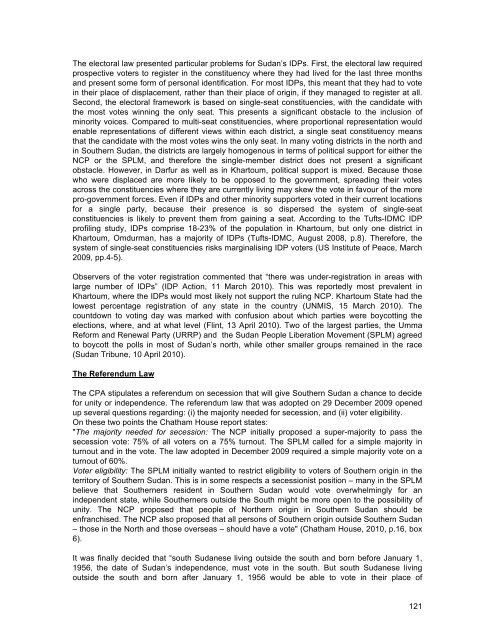SUDAN: Durable solutions elusive as southern IDPs return and ...
SUDAN: Durable solutions elusive as southern IDPs return and ...
SUDAN: Durable solutions elusive as southern IDPs return and ...
Create successful ePaper yourself
Turn your PDF publications into a flip-book with our unique Google optimized e-Paper software.
The electoral law presented particular problems for Sudan’s <strong>IDPs</strong>. First, the electoral law required<br />
prospective voters to register in the constituency where they had lived for the l<strong>as</strong>t three months<br />
<strong>and</strong> present some form of personal identification. For most <strong>IDPs</strong>, this meant that they had to vote<br />
in their place of displacement, rather than their place of origin, if they managed to register at all.<br />
Second, the electoral framework is b<strong>as</strong>ed on single-seat constituencies, with the c<strong>and</strong>idate with<br />
the most votes winning the only seat. This presents a significant obstacle to the inclusion of<br />
minority voices. Compared to multi-seat constituencies, where proportional representation would<br />
enable representations of different views within each district, a single seat constituency means<br />
that the c<strong>and</strong>idate with the most votes wins the only seat. In many voting districts in the north <strong>and</strong><br />
in Southern Sudan, the districts are largely homogenous in terms of political support for either the<br />
NCP or the SPLM, <strong>and</strong> therefore the single-member district does not present a significant<br />
obstacle. However, in Darfur <strong>as</strong> well <strong>as</strong> in Khartoum, political support is mixed. Because those<br />
who were displaced are more likely to be opposed to the government, spreading their votes<br />
across the constituencies where they are currently living may skew the vote in favour of the more<br />
pro-government forces. Even if <strong>IDPs</strong> <strong>and</strong> other minority supporters voted in their current locations<br />
for a single party, because their presence is so dispersed the system of single-seat<br />
constituencies is likely to prevent them from gaining a seat. According to the Tufts-IDMC IDP<br />
profiling study, <strong>IDPs</strong> comprise 18-23% of the population in Khartoum, but only one district in<br />
Khartoum, Omdurman, h<strong>as</strong> a majority of <strong>IDPs</strong> (Tufts-IDMC, August 2008, p.8). Therefore, the<br />
system of single-seat constituencies risks marginalising IDP voters (US Institute of Peace, March<br />
2009, pp.4-5).<br />
Observers of the voter registration commented that “there w<strong>as</strong> under-registration in are<strong>as</strong> with<br />
large number of <strong>IDPs</strong>” (IDP Action, 11 March 2010). This w<strong>as</strong> reportedly most prevalent in<br />
Khartoum, where the <strong>IDPs</strong> would most likely not support the ruling NCP. Khartoum State had the<br />
lowest percentage registration of any state in the country (UNMIS, 15 March 2010). The<br />
countdown to voting day w<strong>as</strong> marked with confusion about which parties were boycotting the<br />
elections, where, <strong>and</strong> at what level (Flint, 13 April 2010). Two of the largest parties, the Umma<br />
Reform <strong>and</strong> Renewal Party (URRP) <strong>and</strong> the Sudan People Liberation Movement (SPLM) agreed<br />
to boycott the polls in most of Sudan’s north, while other smaller groups remained in the race<br />
(Sudan Tribune, 10 April 2010).<br />
The Referendum Law<br />
The CPA stipulates a referendum on secession that will give Southern Sudan a chance to decide<br />
for unity or independence. The referendum law that w<strong>as</strong> adopted on 29 December 2009 opened<br />
up several questions regarding: (i) the majority needed for secession, <strong>and</strong> (ii) voter eligibility.<br />
On these two points the Chatham House report states:<br />
"The majority needed for secession: The NCP initially proposed a super-majority to p<strong>as</strong>s the<br />
secession vote: 75% of all voters on a 75% turnout. The SPLM called for a simple majority in<br />
turnout <strong>and</strong> in the vote. The law adopted in December 2009 required a simple majority vote on a<br />
turnout of 60%.<br />
Voter eligibility: The SPLM initially wanted to restrict eligibility to voters of Southern origin in the<br />
territory of Southern Sudan. This is in some respects a secessionist position – many in the SPLM<br />
believe that Southerners resident in Southern Sudan would vote overwhelmingly for an<br />
independent state, while Southerners outside the South might be more open to the possibility of<br />
unity. The NCP proposed that people of Northern origin in Southern Sudan should be<br />
enfranchised. The NCP also proposed that all persons of Southern origin outside Southern Sudan<br />
– those in the North <strong>and</strong> those overse<strong>as</strong> – should have a vote" (Chatham House, 2010, p.16, box<br />
6).<br />
It w<strong>as</strong> finally decided that “south Sudanese living outside the south <strong>and</strong> born before January 1,<br />
1956, the date of Sudan’s independence, must vote in the south. But south Sudanese living<br />
outside the south <strong>and</strong> born after January 1, 1956 would be able to vote in their place of<br />
121
















